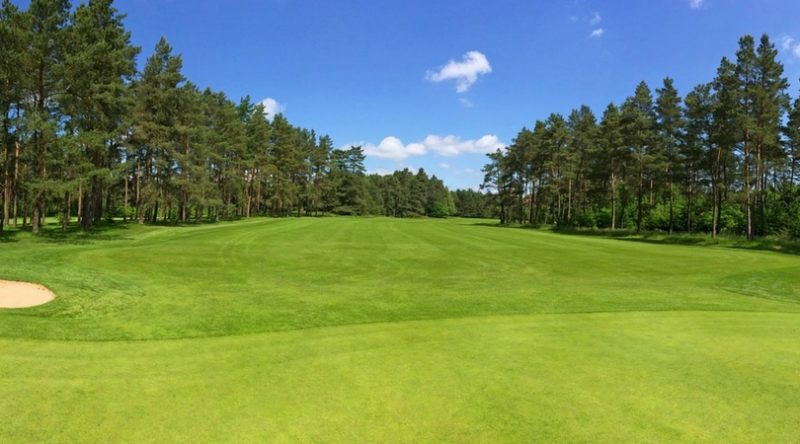“The quality of a golf hole is not based on length, but how interesting it is to play.” – A.W. Tillinghast, designer of many golf courses in the 1920s, four of which are still used for the U.S. Open.
Many American golf courses built during The Golden Age, 1915-1940, are still ranked among the best 100 golf courses in the world. These golf courses were designed by talented, creative, and forward-thinking golf course architects who understood that courses are only interesting if the golf holes are of varied length, present reasonable challenges, and require player strategies.
Current-day golf course architects have the same objectives but face different challenges.
The Influence of Modern Equipment Technology
Technological advancements in golf equipment in the modern golf era have changed the way the game of golf is played. Every year, club and ball manufacturers introduce new models with the promise of more distance and better ball flight control. As a result, golfers of all playing levels and experience are hitting the ball farther.
Today’s golf professionals are routinely driving more than 300 yards. That is 100 yards farther than the average drive in 1920. These longer distances change the way a golf hole is played. Bunkers that were threats off the tee with older equipment are now out of play, while menacing water hazards, rough, and trees may no longer be a consideration. Many older golf courses can no longer be played in the manner conceived by the original golf course architect.
While technology has done wonders for promoting the game, the changes have had a profound impact on golf course design.
Adding Length to the Golf Course
Perhaps the best method to accommodate longer golf shots is simply the addition of length to a golf course. However, modification to existing courses or designing a new course with longer holes has its own set of challenges: lack of space for expanding existing golf courses; additional land required to build a new course; and water conservation concerns.
Lack of Space for Expanding Existing Golf Courses
The distance that golf shots travel is the key issue but a collateral effect is the impact on the landing areas. Golf holes are laid out in the shape of a funnel. The tee areas are the point of the funnel, and it widens to the landing zones and then funnels back down to the green locations.
Typical widths of the funnel at the landing area at one time were acceptable at 280-300 feet. This gave adequate room for the fairway, roughs, bunkering, trees, mounding, golf cart paths, and more.
However, now that golfers are hitting it farther, the fairways must be wider to accommodate errant shots. A landing area of 400 feet is recommended. Many older courses cannot be modified to meet the new requirements simply because the land is unavailable.
Additional Land Required to Build a New Course
A new golf course design is also impacted significantly by these requirements. The additional space, as much as 40 acres required by the longer golf holes, represents a loss of land that at one time could have been sold as lots by the developer. Reduced sales revenues, plus the additional expense of maintaining more golf property, in many instances, can terminate a project.
Water Conservation
Water usage on golf courses has become a serious issue in recent years, especially in areas impacted by drought. The average golf course uses an estimated 130,000 gallons of water a day. For longer and wider courses, the challenge for golf course architects is the design layout and implementation of highly efficient irrigation systems.
New Irrigation System Technologies
Golf course architects are implementing new technologies to achieve a considerable savings of water and energy resources:
- Sophisticated on-site weather stations, weather reporting services, and other resources to determine accurate daily irrigation replacement needs.
- Wireless soil sensing technology that measures soil moisture, salinity, and temperature, allowing superintendents to monitor what is going on beneath the surface of their course. Based on these soil measurements, specific areas that need watering are identified.
- Improved irrigation uniformity and efficiency with careful evaluation of sprinkler head design, nozzle selection, head spacing, pipe size, and pressure selection.
- State-of-the-art computerized control systems and variable frequency drive pumping systems to apply water in the most efficient manner to reduce water and energy consumption.
New Golf Course Design
Perhaps the most important task facing the golf course architect on a new golf course design is to create a challenge for the best players while maintaining the playability and fun for amateurs. Island greens, narrow fairways with high rough on both sides, and water hazards on every hole may present a challenge but, more likely, create a level of frustration for all.
The following are design considerations for making the course challenging without adding length.
- Play a strategy.
Make the players think by creating holes which need strategies, and which have multiple options and tempting challenges from the tee. - Play within your abilities.
Short par 4 golf holes with well-placed hazards are always interesting. Even the longest hitters will have to decide on a strategy: layup or try to drive the green and make an eagle. - Shape the shots.
Use the existing terrain and slopes to design holes that require shots that don’t feel comfortable. Force players to hit a fade from the fairway when standing below the ball or play a draw when standing above the ball. - Deal with steep greenside slopes.
Approach shots that miss a green with steep slopes and the flag near the fringe will require some short game skills: a putt, a high lob, or a chip to the green edge and a slow roll to the pin. - Build in green undulations.
Undulating greens force the player to think a bit more about the approach shot. Instead of shooting for the pin, the player must decide what position will give him the easiest putt. - Carve in creatively shaped fore-greens.
If the greens are firm, the only option may be to land the ball in front of the green and let it roll toward the flag. A creatively shaped fore-green means the golfer must predict the ball’s behavior once it lands. - Locate fairway bunkers strategically.
On a well-designed strategic golf course, the fairway bunker locations impact the player’s club selection and target off the tee. The consequence of failure should be substantial, making the player feel the pressure to make a good shot. - Make visibility challenging.
Golf course architects look for designs that can increase the tension for even the best players. The blind shot can be as intimidating as a visible out of bounds. Water hazards or long carries over rough can force an errant swing. A partially hidden green can elicit a change in strategy.
Final Thoughts
Golf course architects face the serious task of modifying current courses and creating new designs that meet present day requirements driven primarily by equipment improvements and environment concerns. However, they have innovative technology and creative methods to overcome any obstacles and produce challenging and entertaining golf courses.





I think you are missing the point(s). The key issues that are driving new golfers away are the time it takes to play and the cost.
So… how do you reduce the cost and make the game playable in a shorter time span???
Thank you for reading and for your comments. But why does it all of a sudden take too much time? I am a traditionalist. 4+ hours is expected. Especially clubs that promote a time par. I want to show up early, hit balls, grab lunch… I am not in a rush. If I was, then I would play 9 holes. Why try to change something that isn’t broken?
Who should I speak with, or how do I approach a company, to manufacture an item that could be used by every golf course, old and new, to enchance the use of today’s technology in golf?
Mike Hicks
Ashland, Virginia
Thank you for your comments. What did you have in mind? Perhaps I can point you in the right direction.
Again, thank you for reading and for your comments. Hope to hear from you soon, sir.
Thank you for your reply Ricky. I am hoping to find someone to point me in the right direction.
I have dealth with a company to document an item, but they are geared to take on a wide range of industries, commonly, whereas, this item is specifically designed for a golf course to use to enhance the ability of it’s patron’s knowledge and understanding of their game, on virtually every hole!
After reading the material in your writings above, I feel certain an item like this could be constructed into golf courses to be built in the future, but certainly it would have great appeal as an upgrade to all golf courses, old and new, especially because of it’s simplistic, yet highly informative aspects it provides for golfers, as well as the golf course itself.
As this item has been recorded and documented, I would consider providing some material about this product to the right person or company that you think may be able to assist me, even if that person is you Mr. Potts.
I appreciate your time in this matter, and I hope to hear from you again!
Mike Hicks
Ashland, Va.